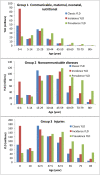History of global burden of disease assessment at the World Health Organization
- PMID: 32850124
- PMCID: PMC7443850
- DOI: 10.1186/s13690-020-00458-3
History of global burden of disease assessment at the World Health Organization
Abstract
Background: The World Health Organization collaborated in the first Global Burden of Disease Study (GBD), published in the 1993 World Development Report. This paper summarizes the substantial methodological improvements and expanding scope of GBD work carried out by WHO over the next 25 years.
Methods: This review is based on a review of WHO and UN interagency work relating to Global Burden of Disease over the last 20 years, supplemented by a literature review of published papers and commentaries on global burden of disease activities and the production of global health statistics.
Results: WHO development of global burden of disease work in the Millenium Development Goal era resulted in regular publication of time series estimates of deaths by cause, age and sex at country level, consistent with UN population and life table estimates, and with cause-specific statistics produced across UN agencies and interagency collaborations. This positioned WHO as the lead agency to monitor many of the 43 health-related indicators for the UN Sustainable Development Goals.In 2007, the Institute of Health Metrics and Evaluation (IHME) was established to conduct new global burden of disease and related work, funded by the Bill and Melinda Gates Foundation (BMGF). WHO was a core collaborator in its first GBD2010 study, but withdrew prior to publication as it was unable to obtain full access input data and methods. The publication of global health statistics by IHME resulted in user confusion and in debate over differences and the reasons for them. The new WHO administration of Director General Dr. Tedros Ghebreyesus has sought to make greater use of IHME outputs for its global health statistics and SDG monitoring.
Conclusions: WHO work on global burden of disease has positioned it to be the lead agency for monitoring many of the UN Sustainable Development Goals. Current moves to use IHME analyses raises a number of issues for WHO and for Member States in relation to WHO's constitutional mandate, its accountability to Member States, the consistency of WHO and UN demographic and health statistics, and the ability of Member States to engage with the results of the complex and computer-intensive modelling procedures used by IHME. As new global health actors and funders have arisen in recent decades, and funding to carry out WHO's expanding mandate has declined, it is unclear whether WHO has the ability or desire to continue as the lead agency for global health statistics.
Keywords: Global burden of disease; Global health statistics; IHME; Sustainable development goals; WHO; World Health Organization.
© The Author(s) 2020.
Conflict of interest statement
Competing interestsThe author declares that he has no competing interests.
Figures
References
-
- World Bank . World Development Report 1993. Investing in health. New York: Oxford University Press for the World Bank; 1993.
-
- Murray CJL, Lopez AD, editors. The global burden of disease: a comprehensive assessment of mortality and disability from diseases, injuries and risk factors in 1990 and projected to 2020. Cambridge: Harvard University Press on behalf of the World Health Organization and the World Bank; 1996.
-
- Murray CJL, Lopez AD. Global health statistics. Cambridge: Harvard University Press; 1996.
-
- Hakulinen T, Hansluwka H, Lopez AD, Nakada T. Global and regional mortality patterns by cause of death in 1980. Int J Epidemiol. 1986;15:226–233. - PubMed
-
- Cooper RS, Osotimehin B, Kaufman JS, Forrester T. Disease burden in sub-Saharan Africa: what should we conclude in the absence of data? Lancet. 1998;351:208–210. - PubMed
LinkOut - more resources
Full Text Sources
Research Materials


